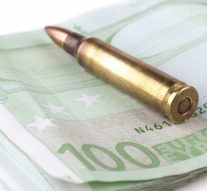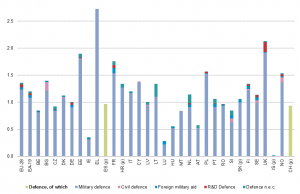
Budgeting the EU Defence
Economy 28 November 2017The integration processes within the security and defence areas, in modern sense date back to the post World War II period, and compounds the international organisations, institutions, (in)formal consultative forums and other international bodies, established in line with the United Nations Charter, under the guaranteed right to individual and collective defence. Since the Charter entered into force, there have been dozens of such a multilateral arrangements. The bilateral agreements signed between the almost all countries of the Eastern Bloc are particularly interesting.
Common Defence and Security Policy of the European Union (EU CSDP), presents the unique type of supranational integration within the security and defence areas, which lasts continuously with the general political European Union integration, and as the official policy, as of 1992, when the Common Foreign and Security Policy has been established as one of the three pillars upon which the European Union was based on. The establishment of the CSDP occurred in 1998 as an operative part of the CFSP.
EU common defence issue has been shadowed from its very beginning since the NATO presence was following the integration process in defence (and mainly in security) area. Every significant attempt initiated directly by the European side to further integrate in defence issues was heavily oppressed by the transcontinental partner – the US. Ever since the EU CSDP has been formally established in 1998/1999, the EU member states have further brought to the agenda the integration in the most likely last field of cooperation – defence. Nice Treaty adopted in 2001, did not however move this issue to the “high level politics”.
Following harsh influence of the Brexit occurred last year in June, the EU has (simultaneously) adopted the EU Global Strategy (EUGS), the most pragmatic act in foreign and security policy. The academic authors have described it as the masterpiece of “realpolitik” action. The remained 27-bloc unanimously decided that further defence and security integration will be “stronger than ever”, and that all the national governments shall stay seized to this matter in near future.
At the same time, the EU has moved fast security and defence. “We have moved more in the last ten months than in the last ten years,” said Mogherini, with EU member states agreeing on an EU command centre for military training and advisory missions. At the European Council this week, EU leaders will discuss further steps in defence, including “Permanent Structured Cooperation” and the setting up of a European Defence Fund. The steps taken have strengthened security on our continent at a critical time.
“European defence has become the strongest pillar for NATO and the strongest reassurance for the transatlantic alliance that Europeans will be there and will continue to be there to keep the military alliance strong.” Over the last year, the EU has defied the narrative about a European Union that is “too slow and bureaucratic” to make any progress, said the High Representative. On the contrary, some may feel the EU is moving too fast. But this “is not the time for taking things slowly. It is the time for putting all the energy in it, thinking carefully, strategically – but going fast.”
PESCO and new budgeting of the EU Defence
Most of the EU Member States have addressed an open letter to the EU HRVP, to “speed up the defence integration process”. Earlier in 2017, the Commission have launched an EU Defence Fund for financing and boosting up the idea of having a common army.
The EU Defence Fund consists of two major components:
- Research: The research aspect of the Fund is already delivering. Starting in 2017, the EU will for the first time offer grants for collaborative research in innovative defence technologies and products, fully and directly funded from the EU budget. Projects eligible for EU funding will focus on priority areas previously agreed by Member States, and could typically include electronics, metamaterials, encrypted software or robotics.
- Development and acquisition: The Fund will create incentives for Member States to cooperate on joint development and the acquisition of defence equipment and technology through co-financing from the EU budget and practical support from the Commission. Member States may for example jointly invest in developing drone technology or satellite communication, or bulk buy helicopters to reduce costs. Only collaborative projects will be eligible, and a proportion of the overall budget will be earmarked for projects involving cross-border participation of SMEs.
The Fund will further implement additional 5.5 billion Euros into the existing defence budgeting architecture. This initiative is however not welcomed by part of the EU Member States which seemingly avoid the defence integration process. From 2018 onwards, the EU defence architecture will be financed in several level processes. In national levels, every EU MS shall have its own defence budget, while contributing at the same time to the EU grants. Also, the national armies will benefit from the EU Defence Fund, as well as the private research companies and institutes. The Commission will also finance wider area of activities within the CSDP/CFSP framework, while the most European states will also benefit from the NATO funded structures such as Operational Headquarters as well as SHAPE and other significant institutional structures based at the European soil.

ec.europe.eu



